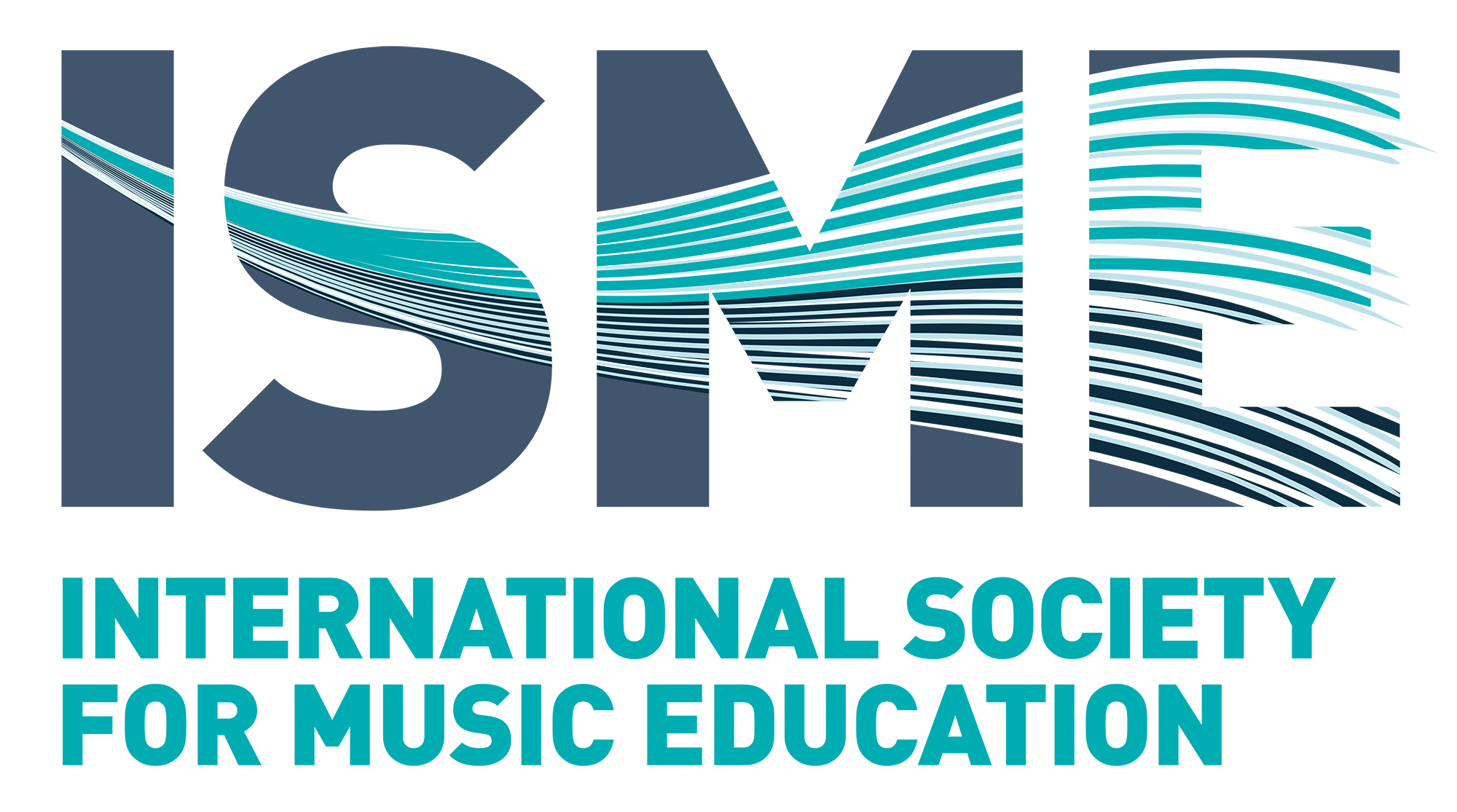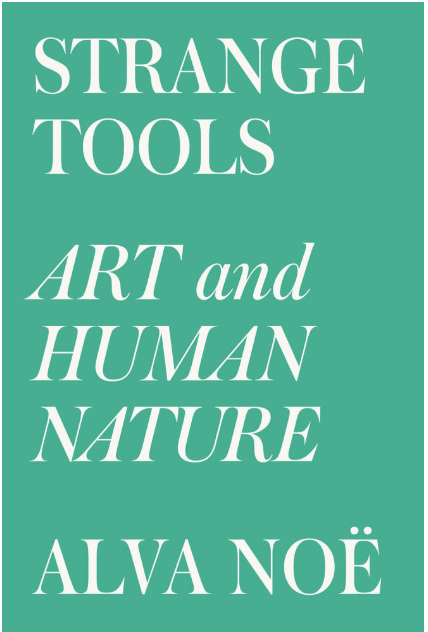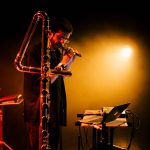Nöe, A. Strange tools: Art and human nature. New York: Farrar, Straus and Giroux.
Review by Bruno Faria
Music teacher in Lund, Sweden, freelance musician, and soundpainter and performer with the Swedish Soundpainting Orchestra.
In Strange Tools—Art and Human Nature (2015) Alva Nöe proposes a new way of understanding and valuing art. The book is focused on art as a whole and it is thus of interest to anyone who appreciates art, is professionally involved with art in whatever form, and who cares about art's presence in our lives. Through examples and discussions about various art forms and their particular ways of addressing us, skilfully weaved with references to personal experiences, the author involves the reader into fresh reconsiderations about the meaning of art and its place in our lives. The very first reference in the book is the strong criticism of an artist who dismissed the scientific awe reported by Nöe in a conversation concerning how our vision can be so rich while the visual input captured by our eyes is so impoverished—“tiny distorted upside-down images in the eyes” (p. xi). The artist proposed that the questioning should be inverted: how can we see so little when we are given so much to perceive? A bold suspicion that the exegetical standpoint of philosophy in relation to art is inadequate is shared upfront. Nöe suggests that scholars (from philosophy and also other fields) might have been missing opportunities to learn from art: "Not because art is cryptoscience, but because it is its own manner of investigation and its own legitimate source of knowledge” (ibid.). In 17 chapters organized in 4 parts, Nöe unpacks his theory providing thoughtful examples, comparisons between the arts and different forms of communication, and his criticism towards scholarly approaches (for example, neuroaesthetics and evolutionary explanations for the existence art).
To Nöe art and our biology are deeply linked. As organisms we get organised when we engage in different activities. Nöe claims that art emerges from an interest in the many ways in which we find ourselves organized, it investigates these ways and puts them on display for us. The author enumerates 6 features that characterize “organized activities” (p. 10). They are (1) natural for us, activities that grow out of our needs and/or to which we are predisposed. (2) Our engagement in them requires and exhibits refined cognitive skills. (3) These activities are structured in time, sometimes having a “turn-taking” character. We are weaved into them and we act in different ways while engaged in them, but (4) we do not author them, “the task itself shapes, enables, and constrains us; we find ourselves put together and made up in the setting of the activity” (p. 5). Although it might be difficult to single out the purpose of our engagement in such activities, (5) they necessarily have a function in our lives. Finally, despite the difficulties we might face in these activities, (6) they are potentially pleasurable to us. Putting up a challenge for the reader the first parallel drawn between an organised activity and the arts in the book illustrates these 6 features: on the natural level Nöe discusses breast-feeding, which he portrays as a model of organised activity and which he understands as a primitive form of communication, while on the artistic level he turns attention to depictions of the nursing mother. How could art be related to breast-feeding? How can nature and culture be so strongly tied?
Nöe articulates further the link between organised activities and the arts by focusing on dancing and choreography, stressing the relation between the two and highlighting the distinguished artistic value of the latter. He compares the naturalness of how one gets caught up in dancing with how an infant gets caught up in suckling instead of choosing to suckle and with how a literate person cannot avoid reading when confronted with a sign on a wall: “you don’t choose to read the sign on the wall. If you can read, you will read. The sign reads you, we might almost say” (p. 12). Dancing, Nöe remarks, is something that emerges out of situations (for example, in celebrations of joy or grief). When we participate in dancing our "movements and actions and thoughts get entrained by the larger organization, the dancing itself” (p. 12). Choreography is something different. While dancing is “emergent” (p. 6), choreography is “staged” (p. 13). The choreographer “puts dancing itself on display” (p. 13) in a similar way as a real state agent furnishes and decorates an apartment in order to stage how it would be like to live there. Nöe does not deny that there is dancing going on in choreography, and he does not want to say that choreography and real state agency have the same goals. For him the significance of choreography lies in its reflectivity, in the attention it directs towards dancing as an essential trait of our being and as an activity through which we become organised. The reader coming from the field of music, for example, might think of parallels between the singing that emerges in certain situations of life and how it differs from musical compositions heard in a concert or a recording. The author selects choreography as an example for all the other art forms and states:
Choreography, and all the arts … seek to bring out and exhibit, to disclose and illuminate, aspects of the way we find ourselves organized . . .Choreography, makes manifest something about ourselves that is hidden from view because it is the spontaneous structure of our engaged activity” (p. 16).
Nöe concludes that art and philosophy carry out the same task: both are “practices (not activities)—methods of research—aiming at illuminating the ways we find ourselves organized and, also, the ways we might reorganize ourselves” (p. 17).
The possibility of reorganizing ourselves upon encounters with art is a distinctive feature of Nöe’s argument. It resonates with the conception that art affords transformation, which other thinkers (for example, John Dewey) articulated previously. To delineate better how art transforms Nöe separates organising activities and reorganizational and investigative practices into two levels, taking advantage of the notions of tools and technologies to clarify the distinction and relation between them. He understands a picture, for example, as a technology; picture making and using as organised activities—level 1, "things we do by nature or second nature" (p. 29); and artistic painting as an investigative practice—level 2, “where the nature of the organization at the lower level gets put on display and investigated” (p. 29). The impressions caused by the latter affect how we engage in the former. Nöe notes, for example, that movements represented in art form become often cited by people when they dance; that the level 2 practice of writing reflects back on speech and "affords us opportunities to think about our talking and so, also, to talk differently” (p. 35). Art is thus understood as a guiding tool that helps us to discover ourselves within different organisational settings, to understand how we are made and what we know as we engage in organised activities, and, crucially, to aid us on our continuous processes of reorganisation.
Tools, understood broadly (for example, a hammer, a picture, a language, a work of art), are instrumental to our thinking process. To Nöe art is a strange tool because it is not embedded in a context of functionality as other tools are. The art tool is specially devised to allow a suspension of the normal course of life events, affording experiences of ecstasy—a highly transformative state of being that removes us from our ordinary ways of perceiving the world. Consequently, it opens paths for reconsiderations, criticism, and learning. Nöe actually observes that art can put up a challenge for us straight away, as if saying “See me if you can!” (p. 101). The art tool allows us to go beyond ourselves and extend our being in special ways.
Consider the experience of being enthralled by music, for example, which can serve as a tool in different ways. The work of pop-musicians makes evident how melodies and rhythms affect and often reign over us, contributing to our understanding and transformation. Nöe says that
Pop musicians put the ways we are, in my sense, organized by song and dance—style—at the first order. We sing to celebrate, or communicate, or rock our child to sleep. Pop musicians put that on display. The existence of such representations of song-and-dance practices alters the way we sing and dance and thus provides new material for artistic play. This generative process doesn't stop” (p. 180).
Furthermore, the author observes also that, in the pop-world, music is often used to reach extra-musical dimensions, serving as a vehicle for exhibiting the personality of an artist, not necessarily inviting deep listening but serving the purposes of conveying attitude, communicating identity, and establishing fashion. A more detailed focus on the creation and arrangement of sound-structures typical of the so-called classical music, on the other hand, is more impersonal and leads to considering sound as what matters most. Against neuroreductionisms Nöe warns that a focus on the triggering of neurological events caused by sound stimuli cannot possibly explain the meaning of musical arts in our lives, insisting that our transactions with the surrounding world play a decisive role on our perception and understanding:
Music is the stuff of human activity. In this it is like speech. And our sensitivity to music is, finally, a curiosity in relation to the ways we act and about the things we make. In particular, it is an attention to the way we sing, or play instruments other than our voices; and this playing is, just that, playing. We do it for the dancer or the audience, and we do so by banging, plucking, hitting, blowing, and hollering out. There is sound, to be sure; just as there is when we talk. And there is rhythm, to be sure, just as there is when we talk and walk and do anything. This is the stuff of music. Music, as an art, puts these structures of tone and timing and intention and melody themselves on display. The idea that music is just sound, detached from making activity, detached from performance, is no less a fantasy than the sense-datum philosopher’s fantasy about human consciousness. Why is music meaningful? Why does it enthral? Because we are rhythmically and melodically and tonally organized; this is a fundamental feature of our embodied living. Music investigates these ways. And it does so, in part, by inventing new ways of entraining ourselves, new ways that build on, refer back to, and play with the old ways (both musical and nonmusical). And because every musician responds to the ways of the musicians before him or her, music refers to a vast body of collective understanding, collective intelligence, collective humor and insight, about all that (p. 188).
A crucial point of the book is that learning bridges natural (biological) and cultural dimensions: “It is our nature to acquire second natures” (p. 7). When considering organized activities as “natural” for us Nöe includes also activities that are clearly cultural (for example, driving, making pictures, playing instruments). On this same track, the author points out the interdependency between acquired habits and skilful activity, which is evident in music performance for example. Habits both enable and constrain. We can (and often do) become unaware of what we know within our habitual ways of doing things in everyday life. Art allows us to experience anew the process of realizing something, of raising our awareness towards something we couldn’t perceive or even least understand at first: “art provides us an opportunity to catch ourselves in the act of achieving our conscious lives, of bringing the world into focus for perceptual (and other forms of) consciousness” (p. xii). Thus, art affords us possibilities for finding ourselves when we are lost in an intricate web of habits (perceptual, cognitive, emotional). Art’s connection with emotion, Nöe suggests, is essentially grounded on this movement from being lost to being found, on the process of “retrieving our bearings” (p. 30).
The investigative work carried out by artists is driven by what Nöe calls “the writerly attitude” (p. 42), which is a level of reflectivity that emerges “at the juncture where our genuine, full-blooded, first-order engagements become problematic for themselves” (p. 43). The writerly attitude does not depend on writing itself and it permeates both non-linguistic forms of expression (for example, music, visual arts, pop-arts) and non-artistic dimensions of life (for example, the development of languages). Such attitude is embodied in the relation between music performance and music notation for example, which Nöe highlights, has a similar stand to the closeness between speech and writing. The latter reflects back on the former, opening up new possibilities for thinking, questioning, and expressing. As a variation on the field of visual arts, the “painterly attitude” (p. 44) allows for the work to go beyond mere depicting or visual representation and to become a call “to wonder what you could possibly see in or with or thanks to a picture” (p. 45). The invitation for questioning remains open: what could one hear, realise, learn in or with or thanks to a musical work?
The discussions and arguments raised in Nöe’s Strange tools are relevant to all engaged with the arts. The author presents insightful reflections that can aid us—artists and educators—in the processes of better understanding our practices and of defending their value in our society. As a reader one could wish for a more balanced attention to different art forms. The author’s background on visual perception and cognition seem to privilege discussions of visual art forms, although relevant discussions on music are present. Nevertheless, the book presents a highly significant theory, weaving thoughts from different areas, and articulating a solid understanding of why art matters to us. As art opens spaces for discussion, a characteristic singled out by Nöe, Strange Tools also does so by means of strong claims and an involving writing style: “Art is not manufacture. Art is not performance. Art is not entertainment. Art is not beauty. Art is not pleasure. Art is not participation in the art world. And art is definitely not commerce. Art is philosophy. Art is putting our true nature on display before ourselves. Because we need to. Art is writing ourselves” (p. 206).
About the reviewer:
Bruno Faria initiated his music studies in Belo Horizonte (Brazil). Holding a masters degree from The University of Iowa (USA) and a PhD from Lund University-Malmö Academy of Music (Sweden), Faria aims for investigating and combining various forms of expression, seeking thoughtfulness as artist, researcher and educator. Currently Faria works as a music teacher in the district of Lund (Sweden), a freelance musician, and as soundpainter and performer with the Swedish Soundpainting Orchestra. Through the practice of soundpainting, especially, Faria has been expanding his expressive and pedagogical possibilities in and beyond music, working also with theatre, visual arts and dance. http://brunofaria.net/













